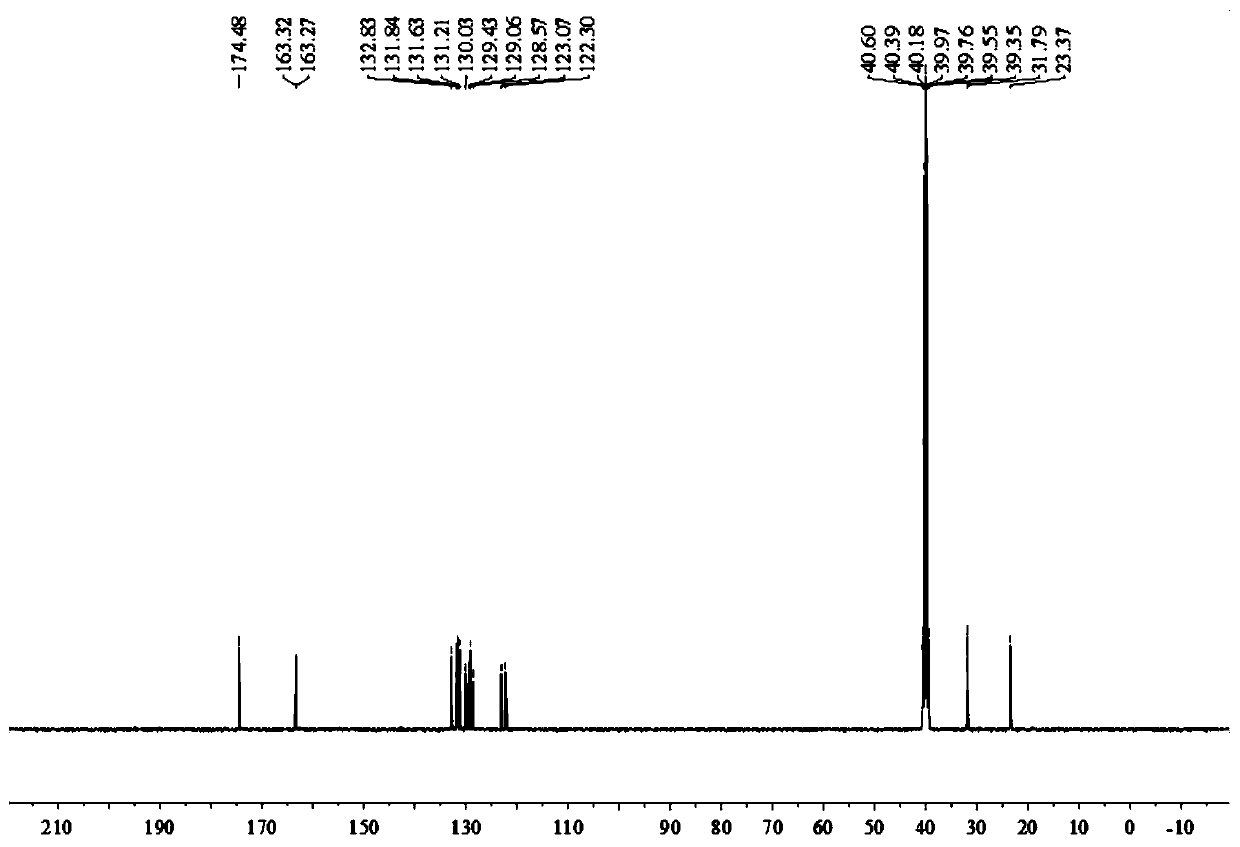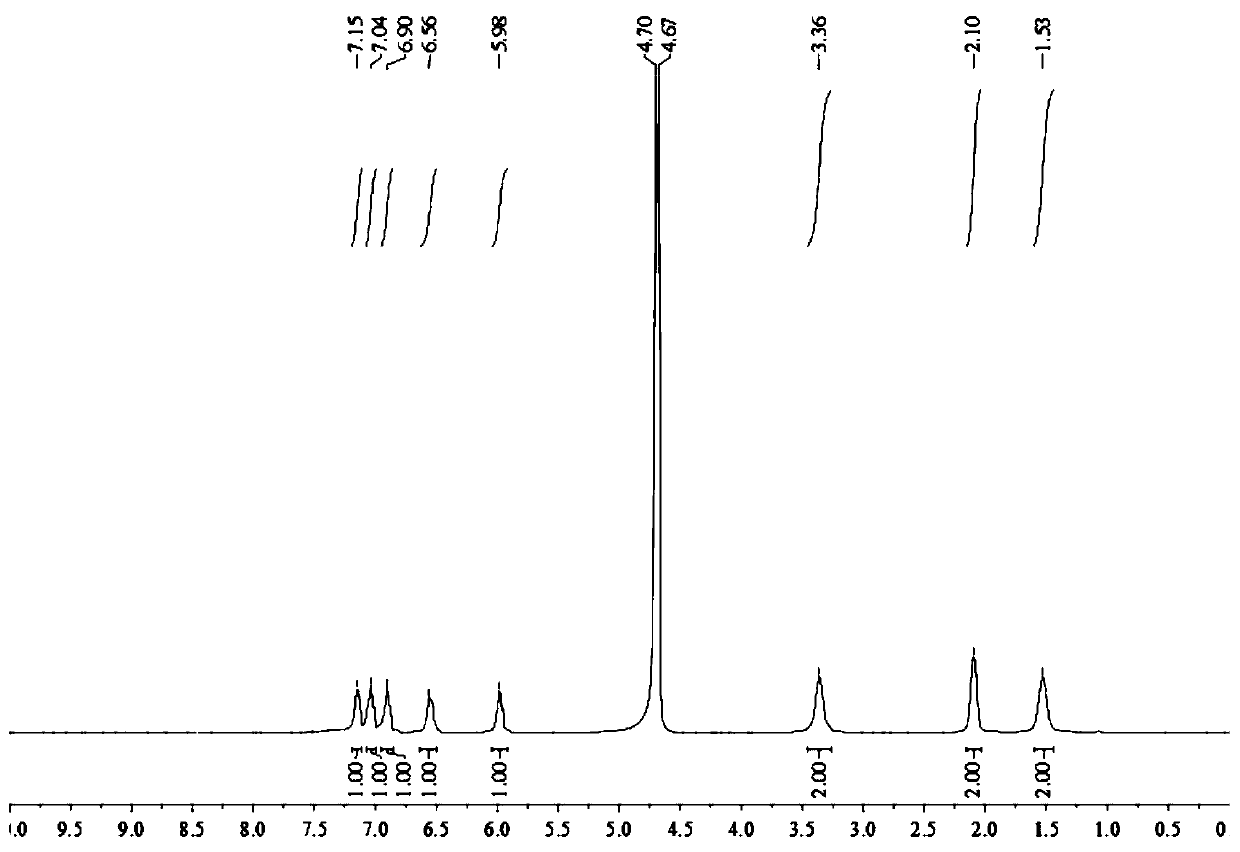Fluorescent probe for formaldehyde detection and preparation method and application thereof
A fluorescent probe and formaldehyde technology, applied in the direction of fluorescence/phosphorescence, chemical instruments and methods, luminescent materials, etc., can solve the problems of expensive reagents, complex structures, and many synthesis steps, and achieve cheap and easy-to-obtain reagents, simple synthesis, and selectivity good recognition effect
- Summary
- Abstract
- Description
- Claims
- Application Information
AI Technical Summary
Problems solved by technology
Method used
Image
Examples
Embodiment 1
[0042] Synthesis of Compound 1:
[0043] Under a nitrogen atmosphere, add 1.00g of 2-bromo-1,8-naphthalene anhydride to 100mL of absolute ethanol, then add 0.41g of 4-aminobutyric acid, and reflux at 80°C for 12h. After the reaction, crystals precipitated after cooling to room temperature, filtered, and washed three times with absolute ethanol to obtain 0.98 g of off-white intermediate compound 1 (yield 74.8%).
[0044] NMR characterization of compound 1: 1 H NMR (400MHz, DMSO-d 6 )δ (ppm): 12.04 (1H, s), 8.40 (2H, dd, J 1 =7.2Hz,J 2=8.2Hz), 8.17(1H,d,J=7.9Hz),8.07(1H,d,J=7.9Hz), 7.87(1H,t,J=6.9Hz),4.03(2H,t,J=6.9 Hz), 2.31(2H, t, J=7.2Hz), 1.84–1.91(2H, m). 13 C NMR (101MHz, DMSO-d 6 )δ (ppm): 174.48, 163.32, 163.27, 132.83, 131.84, 131.63, 131.21, 130.03, 129.43, 129.06, 128.57, 123.07, 122.30, 39.34, 31.79, 23.37.
[0045] Compound 1 1 H NMR spectrum and 13 The C NMR spectra are as follows figure 1 and figure 2 shown.
[0046] Synthesis of Probe HDBC:
[0047]...
Embodiment 2
[0051] Mass spectra of probe HDBC before and after reacting with formaldehyde aqueous solution
[0052] The probe HDBC prepared in Example 1 was dissolved in distilled water to make a test solution with a concentration of 0.1 mg / mL, and the relative molecular weight of the probe was tested by liquid chromatography-mass spectrometry (HPLC-MS), such as Figure 5 , where the signal peak at 312.1 is compound 1+[H + ]. Then add 150 μ M formaldehyde aqueous solution to the above-mentioned probe solution to be tested, after mixing evenly, test the relative molecular weight of the mixed solution with liquid mass spectrometry (HPLC-MS), such as Figure 6 As shown, the signal peak at 325.1 is the final product + [H + ]. Based on the above experimental conclusions, it can be preliminarily proved that the reaction process is consistent with the probe design concept of the present invention.
Embodiment 3
[0054] Changes of Titration Absorbance of Probe HDBC to Formaldehyde Aqueous Solution with Different Concentrations
[0055] The probe HDBC prepared in Example 1 was dissolved in DMSO to prepare a probe mother solution with a concentration of 1 mM; 37% formaldehyde was added to distilled water to prepare a formaldehyde mother solution with a formaldehyde concentration of 1 mM. The above 1 mM probe mother solution was diluted to 10 μM with DMSO to prepare the test solution, and the solution used was sonicated for 10 min with an ultrasonic instrument before use. At room temperature, use a disposable pipette to pipette 3mL of the above-mentioned solution to be tested and add it to a quartz cuvette to start the test; , 80, 90, 100 (unit: μM). The above-mentioned formaldehyde solutions of different concentrations are added to the above-mentioned liquid to be tested, and after mixing evenly, the change of the absorbance of the reaction between the liquid to be tested and different ...
PUM
 Login to View More
Login to View More Abstract
Description
Claims
Application Information
 Login to View More
Login to View More - R&D
- Intellectual Property
- Life Sciences
- Materials
- Tech Scout
- Unparalleled Data Quality
- Higher Quality Content
- 60% Fewer Hallucinations
Browse by: Latest US Patents, China's latest patents, Technical Efficacy Thesaurus, Application Domain, Technology Topic, Popular Technical Reports.
© 2025 PatSnap. All rights reserved.Legal|Privacy policy|Modern Slavery Act Transparency Statement|Sitemap|About US| Contact US: help@patsnap.com



